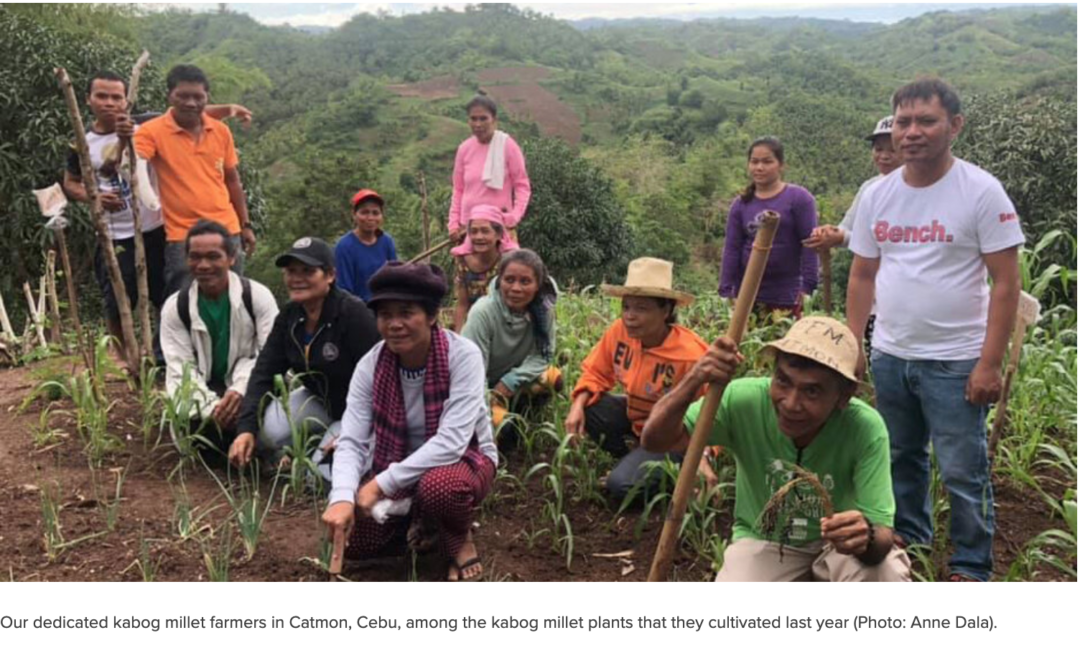Original Article by Joan Oñate Narciso published in Food System Stories
The Philippines has a rich biodiversity and many native plant species are consumed as staple foods. An example of an ancient Philippine crop is the kabog millet, which is cultivated in Cebu. Kabog millet was a native cereal staple food of the Cebuanos long before the Spanish colonizers came to the Philippines. It is used to make budbud kabog, a yellow-colored tube-cake wrapped in banana leaves. Kabog gets its name from folklore: a farmer once discovered millet grains scattered on a cave floor. The cave bats (kabog, in the local language) used the millet as food. Thinking that the seeds were edible, he experimented cooking with it by pounding the millet seeds and added sugar, creating a delicious dish. It became the prototype for budbud kabog, a popular delicacy that Cebuanos are excited to bring home for their families to enjoy.
We interviewed two kabog millet farmers in Cebu, Mr. Nolito Ares (or Tatay Noli as he is fondly called – “Tatay” translates to “Father” in some Philippine languages) and Mr. Simeon Aringay, about kabog millet cultivation and what they envision for kabog millet after COVID-19.
Climate change as major challenge for cultivation
When asked about the major challenges that kabog millet farmers are facing and the problems they encounter in terms of production, both farmers consider climate change as the major challenge in terms of cultivation. They can no more follow the same planting season/schedule each year. The weather can be too dry or too wet. Both is not favorable for kabog millet. In terms of production, the costs of labor are high. The farmers earn only 400 Philippine pesos for each ganta (~7.5 CHF; ganta is an ancient Philippine unit of measurement for volumes : 1 ganta = 8 chupa =3 litres1), which is not enough to cover the production and transportation costs. They need subsidies and support from the local government. Hopefully, with financial support, this will help lower the production costs of the kabog millet and encourage the farmers to keep growing it.
Support from the government is lacking
The kabog millet farmers feel that they are not getting enough help and support from the local government and the Department of Agriculture in the Philippines. Despite the lack of support from the government, there are non-profit organizations that are willing to devote time and resources to put the kabog millet in the market. Notable among them are: 1) Slow Food, an organization based in Italy that promotes local food and traditional cooking, and which highlights the cultural importance of kabog millet in its programs; 2) the Cebu Farmers Market, which provides venues for advertising and sales, and opportunities for the kabog millet farmers to form networks with customers and other vendors who often offer their help and support; 3) CAFEi, a local initiative, which promotes and markets kabog millet by hosting conferences, dinners, and workshops (to read more: http://www.foodsystemstories.org/blog/2020/20/05/planting-seeds-of-hope-in-face-of-a-pandemic); and 4) the Global Seed Savers and the Cebu Seed Savers, which provide the farmers planting and seed saving materials, and serve as crucial avenues for farmers to exchange seeds.
The effects of COVID-19
When asked how they coped and are coping under the COVID-19 lockdowns, they replied that these are desperate times – many farmers could not afford to keep cultivating kabog millet because of low financial returns. They resorted to other ways of earning, such as selling coal and being hired by large industrial farms. Despite their difficult situation, kabog millet farmers realized that to survive, they should plant small amounts for home consumption, and prepare for more to sell when the markets open again.

Visions for the future of kabog millet
When we talked about their dreams and the future they envision for their families and the kabog millet, Tatay Noli and Mr. Aringay told us that they hope that their siblings and children can carry on the practice of kabog cultivation, and recruit others as well. Their vision is that kabog will have a resurgence in the food market, and can be a staple food that still retains its special place in the hearts of the Cebuanos. They also hope that other people will become aware of the importance of kabog to the people of Cebu and find renewed respect for its history and cultural value. Lastly, Tatay Noli, Mr. Aringay, and other kabog millet farmers desire to learn the nutritional value and health benefits of kabog millet, as they, like many of us, long for relevance in what they do and contribute to the needs of the times, the people, and the planet. They believe that propagating the kabog millet as food is their contribution. In this increasingly globalized world, it is critical that we listen to the voices of our farmers, and respect their beliefs, their worries, their dreams, hopes, and visions, and their hard work.

